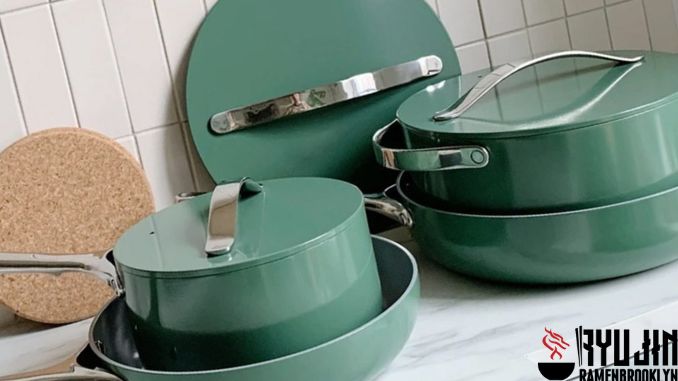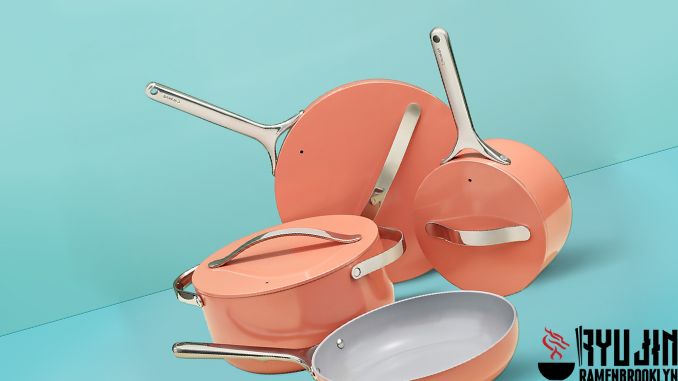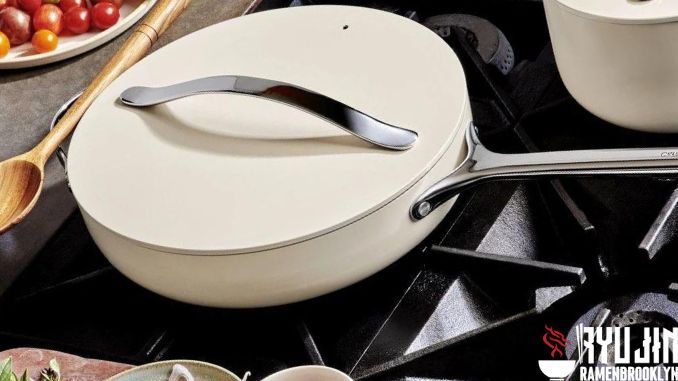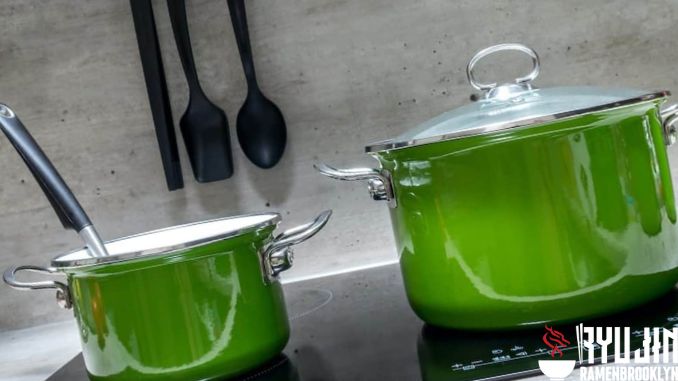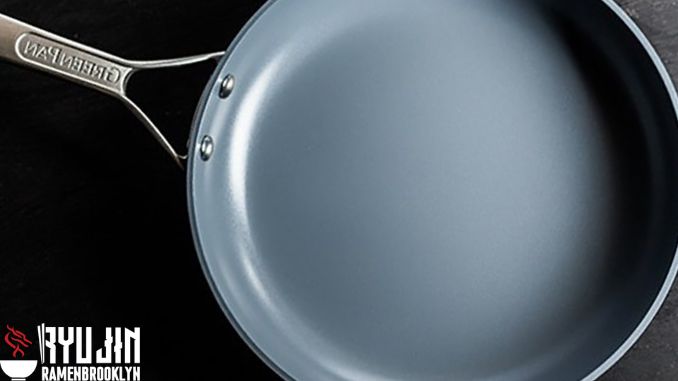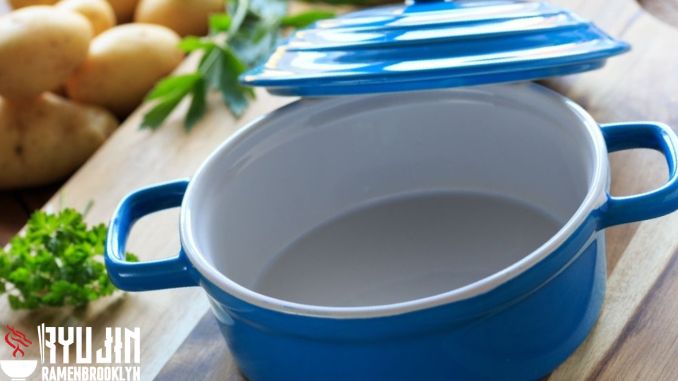Is Ceramic Cookware Safe?
Cooking food is a process that has been around for centuries. It is a way to connect with loved ones, create delicious dishes, and share in the enjoyment of good company. As the years go by, different methods and materials have been used in the kitchen to make cooking easier and more efficient. Cookware is one of those innovations that has made its way into many homes across the globe.
Are you in the market for new cookware? If so, ceramic cookware may be a good option for you. It is a popular choice for many home cooks. Ceramic cookware is made of durable materials that can withstand high temperatures, making it a good choice for stovetop cooking. In addition, ceramic cookware is non-stick, meaning that food doesn’t stick to the pan and makes cleanup easy.
Ceramic-based cookware has been around for centuries, with various types available to suit any need. From casserole dishes and trays to pots and pans you can use on your stovetop or oven heating elements, there’s something perfect just waiting!
There are many positive aspects to ceramic cookware, but it’s also important for you to know the possible dangers. For example, some glazes can transfer from one food item onto another if they’re not designed specifically for each type of pan coating. Certain types may pose greater risks than others because those materials don’t wear down over time like other coatings (which means more particles make their way into our foods). Even highly toxic metals such as Lead could leach out through poorly made pots and pans, causing serious health issues.
So, is ceramic cookware safe to use? In this post, we’ll look at the ceramic cookware research and see what the experts have to say. We’ll also explore some of the benefits of using ceramic cookware and answer some of the people’s most common questions about it. So if you’re wondering whether or not you should switch to ceramic cookware, read on!
See more: Edgestar vs Kalamera Wine Cooler
- What Is Ceramic Cookware?
- The Risks Associated With Using Ceramic Cookware
- Is Ceramic Cookware Safe to Use?
- How to Choose The Right Type of Ceramic Cookware
- FAQs about Ceramic Cookware
- Is Ceramic Cookware Lead-Free?
- Is Ceramic Cookware PFOA PTFE and Cadmium Free?
- What is the Difference Between Ceramic and Porcelain?
- What is the Difference Between Ceramic and Teflon?
- What is the Difference Between Ceramic and Stainless Steel?
- Is Ceramic Cookware Safer Than Stainless Steel?
- Is Ceramic Better Than Non-Stick?
- Is Ceramic Cookware Safe for Induction Cooktops?
- Is Ceramic Cookware Safe for Gas Stoves?
- What is the Best Way to Store Ceramic Cookware?
- How to Use Ceramic Cookware
- How to Clean Ceramic Cookware
- What Does “PFOA-free” or “PFAS free” Mean?
- Do Ceramic Pans Cause Cancer?
- Ceramic-Coated Cookware
- Is a Ceramic Coating Worth It?
- Does Ceramic Hold Up in The Dishwasher?
- 100% Ceramic vs Ceramic Coated
- Is Ceramic Cookware Safe? The Bottom Line
What Is Ceramic Cookware?
Ceramic cookware may be a new concept to some people, but it’s quickly becoming one of the most popular. This is because ceramic has many benefits over other materials like cast iron or stainless steel (which also have their perks). It’s simply thanks to how easy-to-use and practical these pieces can always get when cooking at home with family members around you!
And if all else fails? You’ll never worry about burning anything since this type will preserve food much more efficiently than others. So your ceramic cookware is guaranteed to last you a lifetime if you take care of it correctly.
So what is ceramic cookware, anyway? Ceramic is a type of clay that is shaped and fired in a kiln at high temperatures. This process gives the cookware a non-porous surface that is resistant to staining and durable.
Ceramic cookware has only been around for a few decades, but it has quickly become a popular choice among home cooks. This is because ceramic cookware is non-stick, meaning that food doesn’t stick to the pan and makes cleanup easy.
The ceramic coating on these pots and pans will ensure that your food is cooked perfectly, with no uneven cooking. In other words, the material has high conductivity, which helps heat spread evenly throughout so you don’t have cold spots where there should be hot ones or vice versa!
This means even when entertaining guests, they’ll thankfully enjoy their meal because everything came out just right- unlike some dinners where people only eat half of what’s set before them due to being surprised by an undercooked burger sitting next to overcooked broccoli.
Ceramic cookware has been around for ages and is one of the safest materials to eat from. But when left untreated or not properly cared for in its natural state (which can happen if you use your pot too much), ceramic material will stain over time because smoke caused by fire treatment leaves behind chemicals that are harmful to our health–especially with regards Cadmium which could lead into lung disease!
It also matters where these pots come from: some clays sourced were found to contain high levels while others didn’t show any problems at all even though they’re both composed primarily out of similar clay yet still prone toward stains differently.
See more: What is a Saucepan?
The Risks Associated With Using Ceramic Cookware
The use of unsafe materials in the production of ceramics is not uncommon. Though these dishes can be found as décor items, it’s important to note that they’re not meant for cooking and should only come out when displayed rather than used daily because some merchants may have overlooked their “not-for food” labels which eventually wear off over time or were never present at all in the first place!
The old ceramic pots you find at yard sales may contain Lead, and it’s best not to use them. Lead is a dangerous metal; if it leaks into your food, you could be at risk for health problems. Some people may have been exposed to lead when they were younger because their brains contained more developmental dopamine than average due to behaviors such as theft or cheating, which increase exposure levels beyond what’s considered safe limits.
While the risk of lead exposure from old ceramic pieces may have been minimal when new, with exposure to heat and acidic foods or utensils, a breach could put you at risk for contamination. That’s why we must replace any glazed pot passed down in our families-they might contain dangerous levels of Lead!
Another risk associated with ceramic cookware is the release of Cadmium. Cadmium is a metal that is found in small amounts in the environment. It is mined and used to produce some metals, including zinc and copper. Cadmium is known to cause cancer and is classified as a human carcinogen by the International Agency for Research on Cancer.
Cookware is designed to withstand high temperatures, but some pots and pans can reach up to 700 degrees Fahrenheit. At these scorching hot levels, chemicals like Cadmium are likely seeping into your food through the metal surface due to its ancient makeup, which may also contain Lead!
This poses a great risk for consumption if you happen upon such an item while shopping around town – do not purchase them unless we know exactly what’s inside first, so our health isn’t jeopardized by unhealthy materials used once again before being phased out here in America.
Imagine the worst thing if you cooked with your pans every day. What is it? They get scratched and chipped, which means tiny metal particles end up in food. For instance, when using a ceramic tagine from Morocco or an enamelled cast iron pan, these might result in glazing (a thin layer) and worst-case scenarios such as poison hallucinations caused by high levels of lead pollution at some industrial sites near where they were manufactured.
Ceramic cookware is excellent if it doesn’t show cracks or chips. Beyond the risk of consuming harmful chemicals, bacteria can also reside in these spaces between pieces and cause problems for your health when ingested – not just taste-wise but from diseases such as camplycolic infection, which has been known to cause kidney damage!
To ensure your food is fresh and safe, you must be aware of the risks associated with using suspect cookware. Some foods have increased acidities, such as tomatoes or citrus fruits, which can lead to toxic reactions when heated over time.
This means they’re more likely than other dishes not only to cause short-term illness but may also pose long-term health problems if consumed regularly for an extended period – even just one meal per day cooked on these types could mean 365 annual exposure opportunities!
Is Ceramic Cookware Safe to Use?
There is always some debate surrounding new cooking materials and whether or not they are safe to use. Ceramic cookware is no exception. Ceramic cookware has been around for a long time, and people are still trying to figure out if it’s safe.
Videos exist on YouTube where you can watch an egg swirl around in its pan without any adverse effects or damage. Other websites boast that paper towels easily clean up whatever is left behind by cooking with these pans (that there isn’t much stick). So what does science say about this material?
While there is no definitive answer, we can look at the research that has been done on the topic to get a better understanding of the potential risks and benefits.
One study examined the release of Lead and Cadmium from glazed ceramic cookware. The study found that when the cookware was heated to high temperatures, there was a release of Lead and Cadmium. However, the levels of these metals were below the maximum allowable limits set by the European Union.
A recent study done at Lund University found out some interesting things. First, ceramic surfaces release less perfluorinated compounds than other types of metal utensils, so they’re pretty awesome!
And secondly, they don’t seem too bad according to surface coatings containing PTFE commonly used in non-stick cookware ( which is often debated about being harmful or not).
So while we don’t have a definitive answer on whether ceramic cookware is completely safe, the research that has been done indicates that it is a safer option than other types of cookware.
If you are concerned about the safety of using ceramic cookware, there are a few things you can do to reduce your exposure to Lead and Cadmium.
– Use ceramic cookware that is made in the United States. This is because cookware made in the United States is subject to stricter safety standards than in other countries.
– Do not heat empty ceramic cookware on the stovetop. Heating empty cookware can increase the release of Lead and Cadmium.
– Do not store food in ceramic containers. Store food in glass or stainless steel containers instead.
– Do not use ceramic cookware that is cracked or chipped. Cracks and chips can increase the release of Lead and Cadmium.
How to Choose The Right Type of Ceramic Cookware
Purchasing ceramic cookware is a popular choice for many home cooks. Ceramic cookware is made of durable materials that can withstand high temperatures, making it a good choice for stovetop cooking. In addition, ceramic cookware is non-stick, meaning that food doesn’t stick to the pan and makes cleanup easy.
There are many different types of ceramic cookware on the market, and it can be difficult to know which one is right for you. Here are a few things to consider when choosing ceramic cookware:
– The size of the pan: When choosing a ceramic pan, it is important to consider its size. Ceramic pans come in various sizes, from small frying pans to large stock pots. Choose a size that is appropriate for the recipes you plan to cook.
– The shape of the pan: Ceramic pans come in various shapes, including round, oval, square, and rectangle. Choose a shape that is appropriate for the recipes you plan to cook.
– The type of stovetop you have: Ceramic pans can be used on all stovetops, including gas, electric, and induction. If you have an induction stovetop, you will need to choose a pan made specifically for induction cooking.
– The type of food you plan to cook: When choosing a ceramic pan, it is important to consider the type of food you plan to cook. If you plan to cook delicate foods, such as fish or eggs, you will need to choose a specially designed pan for cooking delicate foods.
– The price: Ceramic cookware is available in a wide range of prices. You can find ceramic pans for as little as $20 or as much as $200. Choose a pan that is within your budget.
When it comes to is ceramic cookware safe, the answer is yes – but only if you choose the right type of ceramic cookware for your needs. Consider the size, shape, and type of food you plan to cook when choosing a ceramic pan. And, be sure to choose a pan that is within your budget.
FAQs about Ceramic Cookware
Is Ceramic Cookware Lead-Free?
Yes, ceramic cookware is Lead-free. The American Ceramic Society defines ceramic as “an inorganic, non-metallic solid that has been prepared by the action of heat and subsequent cooling.” This means that ceramic cookware is made without Lead.
The United States Food and Drug Administration (FDA) has set strict limits on the amount of Lead that can be present in ceramic ware. These limits are based on the leachability of Lead from the glaze into food.
The FDA limit for Lead in ceramic ware is 0.5 per million (ppm). In contrast, the limit for Lead in drinking water is 15 ppm.
This means that the FDA considers ceramics to be a safe material for cookware.
Is Ceramic Cookware PFOA PTFE and Cadmium Free?
Yes, ceramic cookware is PFOA, PTFE, and Cadmium free. These materials are often used in the production of non-stick cookware.
PFOA is a perfluorinated compound that has been linked to cancer in animals. PTFE is the material used to make Teflon non-stick coatings. Cadmium is a heavy metal that can be toxic if consumed in large quantities.
Ceramic cookware is made without these materials. This makes it a safer alternative to other types of cookware.
What is the Difference Between Ceramic and Porcelain?
Ceramic and porcelain are two types of materials used to make cookware. Both ceramic and porcelain are inorganic, non-metallic solids that the action of heat has prepared.
The main difference between ceramic and porcelain is that ceramic is made from clay, while porcelain is made from white clay called kaolin.
Porcelain is a more refined material than ceramic, and it is typically denser and harder. For this reason, porcelain cookware is less likely to chip or crack than ceramic cookware.
Porcelain is also less likely to absorb flavors or odors from food.
What is the Difference Between Ceramic and Teflon?
Teflon is a type of non-stick coating that is applied to cookware. Teflon is made from a synthetic material called polytetrafluoroethylene (PTFE).
PTFE is a fluoropolymer, which means that it contains atoms of both carbon and fluorine. The structure of PTFE is similar to that of graphite, which is why it is sometimes called “artificial graphite.”
The main difference between ceramic and Teflon is that ceramic is a natural material, while Teflon is a synthetic material. Ceramic is made from clay, while Teflon is made from PTFE.
Teflon is more heat-resistant than ceramic, and it is also more non-stick. However, Teflon is not as durable as ceramic and is more likely to chip or peel.
What is the Difference Between Ceramic and Stainless Steel?
The main difference between ceramic and stainless steel is that ceramic is a non-metallic material, while stainless steel is an iron, carbon, and chromium alloy.
Ceramic is made from clay, while stainless steel is made by melting iron ore in a furnace. Stainless steel is more durable than ceramic and less likely to chip or crack.
However, stainless steel is more likely to rust than ceramic.
Is Ceramic Cookware Safer Than Stainless Steel?
There is no definitive answer to this question. Both ceramic and stainless steel are considered to be safe materials for cookware.
Ceramic is a non-metallic material, while stainless steel is an iron, carbon, and chromium alloy. Stainless steel is more durable than ceramic and less likely to chip or crack.
However, stainless steel is more likely to rust than ceramic.
Is Ceramic Better Than Non-Stick?
Both ceramic and non-stick cookware have their advantages and disadvantages.
Ceramic is a natural material, while non-stick is a synthetic material. Moreover, ceramic is more heat-resistant than non-stick and is also more durable.
However, ceramic is less non-stick than non-stick cookware and is more likely to chip or crack.
Non-stick cookware is easier to clean than ceramic but is not as durable.
Is Ceramic Cookware Safe for Induction Cooktops?
Yes, ceramic cookware is safe for induction cooktops. Induction cooktops use an electromagnetic field to generate heat, and ceramic is a non-conductive material.
This means that ceramic cookware will not be affected by the electromagnetic field, and it will not heat up.
Is Ceramic Cookware Safe for Gas Stoves?
No need to worry about your gas stovetop being a fire hazard. The ceramic material makes it very resistant and durable against heat, meaning that you can use these pots without worrying whether they’ll melt or spark when cooking with an open flame as most other cookware does!
What is the Best Way to Store Ceramic Cookware?
The best way to store ceramic cookware is to place it in a cool, dry place. It is important to avoid storing ceramic cookware in a humid environment, as this can cause the cookware to crack or break.
When not in use, it is also important to cover the cookware with a lid or plate to protect it from dust and debris.
How to Use Ceramic Cookware
Now that we’ve answered the question “is ceramic cookware safe?” it’s time to learn how to use it. Ceramic cookware is easy to use and can be used on all stovetops, including gas, electric, and induction.
When using ceramic cookware for the first time, it is important to season the pan. Seasoning the pan will help create a non-stick surface. To season the pan, simply rub a small amount of oil into the pan’s surface. Then, heat the pan on the stovetop over medium heat for two minutes. Once the pan is heated, remove it from the stove and allow it to cool. Repeat this process three times.
Once your pan is seasoned, you can use it for cooking all your favorite recipes. When cooking with ceramic cookware, it is important to use lower temperatures than you would use with other types of cookware. This is because ceramic is a good conductor of heat and can easily overheat.
How to Clean Ceramic Cookware
Ceramic cookware is easy to clean. Simply wash the pan with warm soapy water and a non-abrasive sponge. If food is stuck to the pan’s surface, soak the pan in warm soapy water for a few minutes before cleaning.
After washing, it is important to dry the cookware thoroughly to prevent water spots.
Do not use abrasive cleaners or scrubbers on ceramic cookware. Abrasive cleaners will damage the non-stick surface of the pan.
Do not put ceramic cookware in the dishwasher. The high temperatures of the dishwasher can damage the pan.
Here are some tips on how to care for your ceramic cookware:
-Avoid using abrasive cleaners or scrubbers when washing your ceramic cookware. This can damage the non-stick coating and make the cookware more likely to stain.
-Don’t place hot ceramic cookware directly onto a cold surface. This can cause the cookware to crack.
-Allow ceramic cookware to cool gradually by placing it on a wire rack before putting it away in storage.
-Use wooden or silicone utensils to avoid scratching the surface when cooking with ceramic cookware.
What Does “PFOA-free” or “PFAS free” Mean?
PFOA is an acronym that stands for perfluorooctanoic acid. PFAS is an acronym that stands for perfluoroalkyl and polyfluoroalkyl substances.
PFOA and PFAS are synthetic chemicals used in manufacturing non-stick cookware, waterproof clothing, and stain-resistant fabrics.
PFOA and PFAS have been linked to various health problems, including cancer, reproductive toxicity, endocrine disruption, and immune system damage.
In 2016, the U.S. Environmental Protection Agency launched a voluntary program to reduce the use of PFOA and PFAS in consumer products.
Many manufacturers have since reformulated their products to be PFOA-free or PFAS-free.
These terms are often used to describe certain types and brands when they’ve been deemed non-toxic based on their materials alone without any other testing is done for safety purposes such as compliance with regulations outlined in regards to environmental protection legislation took place around our world today due largely because many people believe these compounds can’t be harmful if ingested orally which could lead to health problems down the road.
Do Ceramic Pans Cause Cancer?
There is no evidence to suggest that ceramic cookware causes cancer. Ceramic cookware is made from inorganic materials that do not release chemicals when heated.
Ceramic-Coated Cookware
Metal is back with a vengeance! Metal has been considered one of the most versatile materials for cooking, and now it’s used in more high-end pans. Ceramic coated cookware features metal surfaces that are covered by silicon or other organic compounds which do not contain carbon, meaning they can be heated up to 500 degrees Fahrenheit without permanently sticking onto your food source; this also makes them safe enough to use within 350 -500 degree ranges typically seen on modern-day kitchen appliances (about same as Teflon).
Ceramic-coated cookware is designed to handle the cold and heat, but it shouldn’t be attempted in some circumstances. For example, don’t take a pan out of your fridge or freezer; put it on a hot burner because this could crack the coating.
A great way for you all to get started with cooking nutritious meals at home has been by using quality ceramic coated pans! These amazing items will last longer than normal metal ones and are much lighter, so fewer dishes are needed when making dinner time a breeze.
Is a Ceramic Coating Worth It?
Ceramic cookware is coated with a thin layer of ceramic. This coating is designed to improve the pan’s non-stick properties and make it easier to clean.
A ceramic coating is not necessary for the pan to be safe or effective. However, some people prefer the added convenience of a non-stick surface.
If you are considering purchasing ceramic cookware, read the label carefully. Some companies use terms like “ceramic” or “coated” to describe their products, but these terms do not necessarily mean that the cookware is made from pure ceramic.
When shopping for ceramic cookware, look for products labelled as “100% ceramic.” These products are made from pure ceramic and contain no other materials.
Does Ceramic Hold Up in The Dishwasher?
Ceramic cookware is not dishwasher safe. The high temperatures of the dishwasher can damage the pan.
If you need to wash your ceramic cookware in the dishwasher, use the lowest setting and allow the pan to cool completely before removing it from the dishwasher.
100% Ceramic vs Ceramic Coated
The best cookware is pure ceramic, made from a substance containing no metal and heated at more than 1900 degrees Fahrenheit / 1038 Celsius to create its signature black color. You can use your favorite utensils on these pots without worrying about scratches or marks – they’re even dishwasher safe!
The ceramic coating on these pans is durable but also lightweight. This makes them perfect for cooking with oil or fat-based substances like fried foods! The aluminum base means they’re never going off balance, even if you happen to add too much water while making your dish. And because of their high-quality materials, they’re oven safe up to 500 degrees Fahrenheit.
So, what is the difference between 100% ceramic and ceramic-coated cookware? It all comes down to the manufacturing process and the materials used. 100% ceramic cookware is made from a single piece of clay that is molded and fired in a kiln, whereas ceramic coated cookware is made from metal that is then coated with a layer of ceramic.
Both types of cookware are safe to use, but if you’re looking for the best possible option, go with 100% ceramic. Ceramic-coated cookware is also a great choice if you want something more affordable.
Is Ceramic Cookware Safe? The Bottom Line
When it comes to ceramic cookware, the question “is ceramic cookware safe?” is often asked. And rightfully so – with all the different types of cookware on the market, it can be hard to know which ones are safe to use and which aren’t. But when it comes to ceramic cookware, you can rest assured that it is a safe and non-toxic option.
Ceramic cookware is safer than other types of cookware, like aluminum or non-stick cookware. Ceramic cookware is easy to use and is PFOA-free and PFAS-free. When shopping for ceramic cookware, look for products labelled as “PFOA-free” or “PFAS-free.”
So, if you’re wondering, “is ceramic cookware safe?” the answer is a resounding yes! Ceramic cookware is a safe, non-toxic option that is easy to use. So go ahead and cook up your favorite recipes in ceramic cookware – your body will thank you for it.
If you have any further questions about is ceramic cookware safe, please feel free to contact us. We would be more than happy to answer any of your questions. You can also visit our website to refer to more useful information.
Anthony Michelin (March 26, 1960) is the CEO of Ryujinramenbrooklyn.com – is an expert in finding specialized equipment to assist in the Bar & Kitchen sector. With over 40 years of focus on finding the simplest recipes on the most suitable cookware to create the most delicious meals, I believe it will help you.
